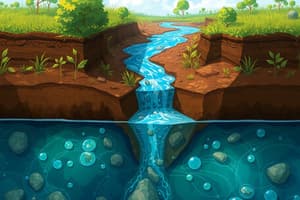Podcast
Questions and Answers
Which stage is NOT part of the infiltration process?
Which stage is NOT part of the infiltration process?
- Movement within the soil profile
- Soil profile storage
- Surface entry
- Water evaporation (correct)
What is one of the key soil properties that affects infiltration?
What is one of the key soil properties that affects infiltration?
- Color of the soil
- pH level
- Porosity (correct)
- Temperature
How do montmorillonitic clay soils affect infiltration after wetting?
How do montmorillonitic clay soils affect infiltration after wetting?
- They increase permeability.
- They cause soil erosion.
- They swell and reduce permeability. (correct)
- They maintain high infiltration rates.
Which method is seldom used due to practical difficulties in measuring initial infiltration rates?
Which method is seldom used due to practical difficulties in measuring initial infiltration rates?
Which statement regarding vegetation's role in infiltration is correct?
Which statement regarding vegetation's role in infiltration is correct?
What physical property of water influences its infiltration into soil?
What physical property of water influences its infiltration into soil?
Which soil type is characterized by high infiltration rates?
Which soil type is characterized by high infiltration rates?
Which of the following factors is least likely to affect infiltration?
Which of the following factors is least likely to affect infiltration?
What is the main advantage of using hydrograph analyses in infiltration studies?
What is the main advantage of using hydrograph analyses in infiltration studies?
Which of the following correctly describes the Lewis-Kostiakov equation?
Which of the following correctly describes the Lewis-Kostiakov equation?
What was Horton’s contribution to the understanding of infiltration rates?
What was Horton’s contribution to the understanding of infiltration rates?
In the Gardner and Windsoe Equation, what do the constants C1 and C2 represent?
In the Gardner and Windsoe Equation, what do the constants C1 and C2 represent?
What does the Philip equation primarily analyze?
What does the Philip equation primarily analyze?
Which phenomenon does the term 'exhaustion phenomenon' refer to in Horton’s analysis?
Which phenomenon does the term 'exhaustion phenomenon' refer to in Horton’s analysis?
Which condition allows the Lewis-Kostiakov equation to apply effectively?
Which condition allows the Lewis-Kostiakov equation to apply effectively?
What does the cumulative infiltration rate (i) indicate in the context of infiltration equations?
What does the cumulative infiltration rate (i) indicate in the context of infiltration equations?
Flashcards
Infiltration
Infiltration
The process of water entering the soil surface.
Initial Infiltration Rate
Initial Infiltration Rate
The high rate of infiltration at the beginning of water entry.
Soil Porosity
Soil Porosity
The amount of empty space within the soil.
Soil Structure
Soil Structure
Signup and view all the flashcards
Antecedent Soil Moisture
Antecedent Soil Moisture
Signup and view all the flashcards
Infiltrometer
Infiltrometer
Signup and view all the flashcards
Basin Method
Basin Method
Signup and view all the flashcards
Watershed Hydrograph
Watershed Hydrograph
Signup and view all the flashcards
What is the main advantage of the procedure to subtract surface runoff rates?
What is the main advantage of the procedure to subtract surface runoff rates?
Signup and view all the flashcards
What type of equation is used to represent infiltration?
What type of equation is used to represent infiltration?
Signup and view all the flashcards
Gardner and Windsoe Equation
Gardner and Windsoe Equation
Signup and view all the flashcards
Lewis-Kostiakov Equation
Lewis-Kostiakov Equation
Signup and view all the flashcards
What does Lewis-Kostiakov equation imply about infiltration at t → ∞?
What does Lewis-Kostiakov equation imply about infiltration at t → ∞?
Signup and view all the flashcards
Horton Equation
Horton Equation
Signup and view all the flashcards
Philip Equation
Philip Equation
Signup and view all the flashcards
What does Philip Equation represent?
What does Philip Equation represent?
Signup and view all the flashcards
Study Notes
Infiltration
- Infiltration is the passage of water into the soil surface.
- Initially, infiltration rates are high, but they decrease over time.
- Factors affecting infiltration include:
- Fluid properties (viscosity, turbidity, water depth)
- Soil properties (porosity, structure, surface stability, moisture holding capacity, antecedent soil moisture, mineralogy)
- Vegetation and soil cultural practices (vegetal cover protects soil, tillage increases surface entry rate)
Measurement of Infiltration
- Methods for measuring infiltration include:
-
Infiltrometers: Commonly involve a double ring design; water is added to the inner ring and infiltration is measured over time. Specific details like the size (60 cm ring, 30 cm ring, 12 cm above soil surface, 15 cm into soil) of the rings are noted.
-
Basin Method: Involves flooding a large area and measuring the rate of drop in ponded water depth over time. It is not a practical method.
-
Watershed Hydrograph Method: Involves analyzing runoff and rainfall from watersheds to characterize infiltration. The procedure subtracts runoff rates from total streamflow and adjusts for evapotranspiration and detention.
-
Infiltration Equations
-
Gardner and Windsoe Equation (1921): i = C₁t + C2 (1-e-kt) (where i is cumulative infiltration, t is time, and C1, C2, and k are constants)
-
Lewis-Kostiakov Equation (1932, 1937): i = cta; f = act(a-1)(where i is cumulative infiltration, t is time, and c and a are constants)
- The equation applies best when the soil has an impermeable layer beneath it.
-
Horton Equation (1940): i = fc + (f0 - fc)(1 - e-kt) (where i is infiltration rate, fc is the final constant rate of infiltration, f0 is the initial maximum rate of infiltration, t is time and k is a decay constant)
- This equation considers that continuous infiltration and wetting affect the rate of infiltration.
-
Philip Equation (1957): i = St1/2 + At (where i is infiltration rate, S and A are constants, and t is time)
- This is a partial differential equation describing water movement as a rapidly converging series, often truncated fairly readily.
Studying That Suits You
Use AI to generate personalized quizzes and flashcards to suit your learning preferences.




